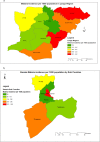Asymptomatic malaria infection, associated factors and accuracy of diagnostic tests in a historically high transmission setting in Northern Uganda
- PMID: 36550492
- PMCID: PMC9783970
- DOI: 10.1186/s12936-022-04421-1
Asymptomatic malaria infection, associated factors and accuracy of diagnostic tests in a historically high transmission setting in Northern Uganda
Abstract
Background: Asymptomatic malaria infections are important parasite reservoirs and could sustain transmission in the population, but they are often unreported. A community-based survey was conducted to investigate the prevalence and factors associated with asymptomatic malaria infections in a historically high transmission setting in northern Uganda.
Methods: Using a cross-sectional design, 288 children aged 2-15 years were enrolled and tested for the presence of malaria parasites using rapid diagnostic tests (RDTs) and blood smear microscopy between January to May 2022. Statistical analysis was performed using the exact binomial and Fisher's exact test with p ≤ 0.05 indicating significance. The logistic regression was used to explore factors associated with asymptomatic malaria infections.
Results: Overall, the prevalence of asymptomatic infection was 34.7% (95% CI 29.2-40.5) with the highest observed in children 5-10 years 45.9% (95% CI 35.0-57.0). Gweri village accounted for 39.1% (95% CI 27.6-51.6) of malaria infections. Median parasite density was 1500 parasites/µl of blood. Plasmodium falciparum was the dominant species (86%) followed by Plasmodium malariae (5%). Factors associated with asymptomatic malaria infection were sleeping under mosquito net (Adjusted Odds Ratio (aOR) 0.27; 95% CI 0.13-0.56), p = 0.001 and presence of village health teams (VHTs) (aOR 0.02; 95% CI 0.01-0.45), p = 0.001. Sensitivity and specificity were higher for the P. falciparum/pLDH RDTs compared to HRP2-only RDTs, 90% (95% CI 86.5-93.5) and 95.2% (95% CI 92.8-97.7), p = 0.001, respectively.
Conclusion: Asymptomatic malaria infections were present in the study population and this varied with place and person in the different age groups. Plasmodium falciparum was the dominant parasite species however the presence of P. malariae and Plasmodium ovale was observed, which may have implication for the choice and deployment of diagnostic tools. Individuals who slept under mosquito net or had presence of functional VHTs were less likely to have asymptomatic malaria infection. P.f/pLDH RDTs performed better than the routinely used HRP2 RDTs. In view of these findings, investigation and reporting of asymptomatic malaria reservoirs through community surveys is recommended for accurate disease burden estimate and better targeting of control.
Keywords: Asymptomatic malaria infections; Blood smear microscopy; Rapid diagnostic.
© 2022. The Author(s).
Conflict of interest statement
All authors declare that they have no competing interests.
Figures



References
-
- WHO . World Malaria Report. Geneva: World Health Organization; 2021.
-
- WHO . World Malaria Report. Geneva: World Health Organization; 2018.
-
- Ministry of Health. Routine District Health Information Management System, Uganda. 2020.
-
- NMCP. Uganda Malaria Indicator Survey (MIS). Kampala, Uganda, 2019.
-
- NMCP. Uganda National Malaria Control Reduction Strategy. Kampala, Uganda,
MeSH terms
Substances
LinkOut - more resources
Full Text Sources
Medical

